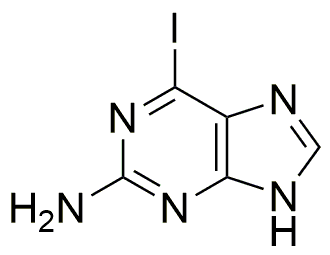2-Amino-6-iodopurine is widely utilized in research focused on
- Pharmaceutical Development: This compound serves as an important intermediate in the synthesis of antiviral and anticancer drugs, providing a basis for developing new therapies.
- Genetic Research: It is used in the study of nucleic acids, particularly in the development of modified nucleotides that can enhance the understanding of genetic mechanisms.
- Biotechnology: In the field of biotechnology, it aids in the design of novel biomolecules, contributing to advancements in genetic engineering and synthetic biology.
- Diagnostic Tools: The compound can be incorporated into diagnostic assays, improving the sensitivity and specificity of tests for various diseases.
- Research on Purine Metabolism: It is instrumental in studying purine metabolism, helping researchers understand metabolic disorders and develop targeted treatments.
Informations générales
Propriétés
Sécurité et réglementation
Applications
2-Amino-6-iodopurine is widely utilized in research focused on
- Pharmaceutical Development: This compound serves as an important intermediate in the synthesis of antiviral and anticancer drugs, providing a basis for developing new therapies.
- Genetic Research: It is used in the study of nucleic acids, particularly in the development of modified nucleotides that can enhance the understanding of genetic mechanisms.
- Biotechnology: In the field of biotechnology, it aids in the design of novel biomolecules, contributing to advancements in genetic engineering and synthetic biology.
- Diagnostic Tools: The compound can be incorporated into diagnostic assays, improving the sensitivity and specificity of tests for various diseases.
- Research on Purine Metabolism: It is instrumental in studying purine metabolism, helping researchers understand metabolic disorders and develop targeted treatments.
Documents
Fiches de données de sécurité (FDS)
La FDS fournit des informations de sécurité complètes sur la manipulation, le stockage et l’élimination du produit.
Spécifications du produit (PS)
Le PS fournit une description complète des propriétés du produit, notamment sa composition chimique, son état physique, sa pureté et les exigences de stockage. Il détaille également les plages de qualité acceptables et les applications prévues du produit.
Certificats d'analyse (COA)
Recherchez des certificats d'analyse (COA) en saisissant le numéro de lot du produit. Les numéros de lot et de lot se trouvent sur l'étiquette d'un produit, après les mots « Lot » ou « Lot de fabrication ».
Numéro de catalogue
Numéro de lot/série
Certificats d'origine (COO)
Ce certificat d'exploitation confirme le pays dans lequel le produit a été fabriqué, et détaille également les matériaux et composants utilisés et s'il est issu de sources naturelles, synthétiques ou autres sources spécifiques. Ce certificat peut être requis pour les douanes, le commerce et la conformité réglementaire.
Numéro de catalogue
Numéro de lot/série
Fiches de données de sécurité (FDS)
La FDS fournit des informations de sécurité complètes sur la manipulation, le stockage et l’élimination du produit.
DownloadSpécifications du produit (PS)
Le PS fournit une description complète des propriétés du produit, notamment sa composition chimique, son état physique, sa pureté et les exigences de stockage. Il détaille également les plages de qualité acceptables et les applications prévues du produit.
DownloadCertificats d'analyse (COA)
Recherchez des certificats d'analyse (COA) en saisissant le numéro de lot du produit. Les numéros de lot et de lot se trouvent sur l'étiquette d'un produit, après les mots « Lot » ou « Lot de fabrication ».
Numéro de catalogue
Numéro de lot/série
Certificats d'origine (COO)
Ce certificat d'exploitation confirme le pays dans lequel le produit a été fabriqué, et détaille également les matériaux et composants utilisés et s'il est issu de sources naturelles, synthétiques ou autres sources spécifiques. Ce certificat peut être requis pour les douanes, le commerce et la conformité réglementaire.


